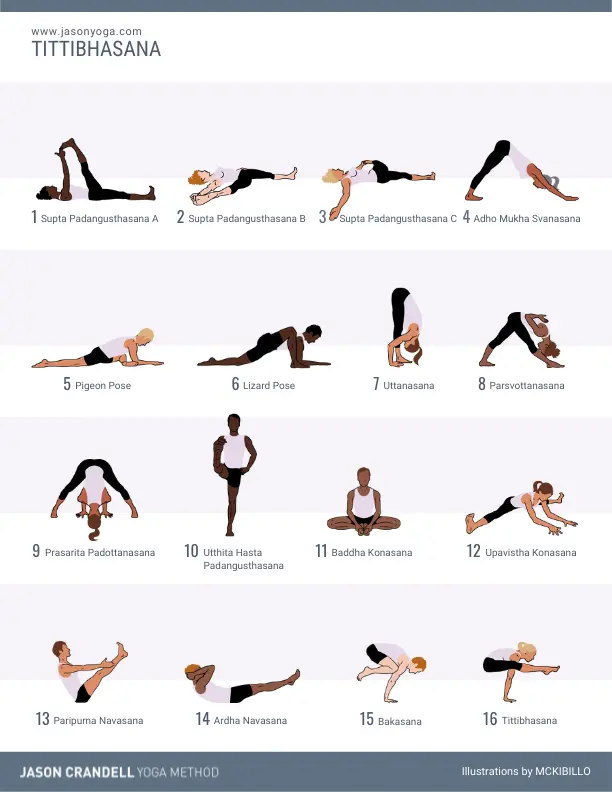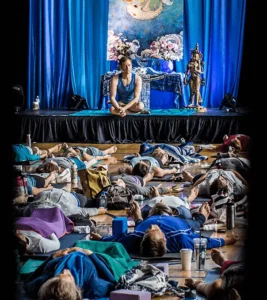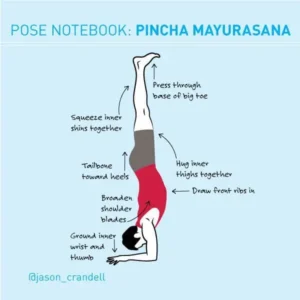In my 500-hour Teacher-Training Programs I have my students compare Bakasana and Titthibhasana, or Firefly Pose, with the aim of learning how to create effective sequences for each of these postures.
When the trainees look at the two poses side-by-side, they see something they usually haven’t noticed before: Bakasana and Tittibhasana (Firefly Pose) are nearly the exact same pose. However, the one major difference between the two postures has significant sequencing implications. We’ll get to the yoga sequencing implications in a moment. But first, let’s look at the similarities between the two poses. Take a moment to compare Bakasana and Tittibhasana (Firefly Pose) below.

Bakasana and Titthibhasana share the following similarities:
1. Both poses flex the spine.
2. Both poses broaden the scapulae while strongly engaging the serratus anterior.
3. Both poses require strong core engagement, most significantly the transverse abdominus, the rectus abdominus, and the illio-psoas.
4. The shoulder joint (or gleno-humeral joint for you fact-checkers out there) is at approximately 90 degrees of flexion in both poses.
5. Both poses strongly flex the hip joints and require the adductors (inner thigh muscles) to engage to prevent the legs from sliding down the arms.
In simple terms, the arms, shoulders, shoulder blades, spine, core, and hips are doing the same thing in Bakasana and Tittibhasana.
The one significant difference between the two poses is that the legs are bent in Bakasana and they’re straight in Tittibhasana. That’s all folks.
But—and this is a big BUT—straightening the legs has far-reaching implications that makes sequencing for Tittibhasana different than sequencing for Bakasana. When you straighten your knees in Tittibhasana (Firefly Pose) you:
1. Stretch your hamstrings. The hamstrings are contracting in Bakasana, but they’re stretching in Tittibhasana. This means your students need plenty of hamstring preparations in the sequence that you create.
2. Stretch and contract your adductor muscles. Tittibhasana requires you to stretch the adductors since the legs open at a slight angle when you straighten the knees in this pose. At the same time, the pose requires you to engage your adductors so that your legs don’t slide down your arms. To facilitate this, your sequencing needs to include both adductor opening and strengthening.
3. Engage your core (even more). If your hamstrings and adductors are the least bit tight, they will pull the weight of your body down as soon as you start straightening your legs. To counteract this downward pull, you have to fire up your core and create even greater lift than you do in Bakasana.
4. Engage your quads: Engaging your quads straightens your knees in Tittibhasana (Firefly Pose). Your quads also work with your core to flex your hips and support the weight of your pelvis. Your sequence and your verbal cueing should include postures that help your students tune into these muscles so they know how to engage them once it’s time for Tittibhasana.
Practice the 16-pose sequence above and notice how all of these layers are incorporated. Let me know how it goes in the comment section below!
See also Essential Sequence: Bakasana
When you understand the nuances of postures like Bakasana and Tittibhasana, you can help demystify these poses for your students. Even more, you can create logical, effective sequences that keep your classes fresh and help your students do more than they ever thought they could.
{illustrations by MCKIBILLO}
Want more sequences by Jason?
Sign up to join our newsletter and we’ll send you our e-book:
30 Essential Home Practice Sequences.



